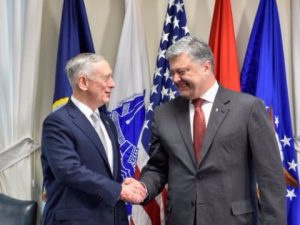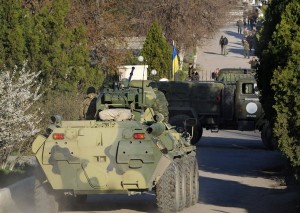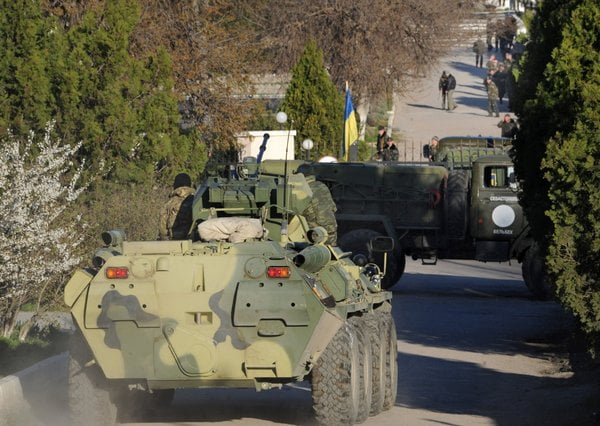2018-02-11 By Stephen Blank
Although the U.S. announced late in 2017 that it would transfer Javelin anti-tank missiles to Ukraine; nobody should think that this transaction suffices or will terminate USA defense ties to Ukraine.
Quite the opposite, in fact, is true.
This relationship is only beginning and in the interests of both parties needs to go further.
There has been no progress on the political negotiations between Ambassador Kurt Volker and Vladimir Surkov of Russia.
Indeed, Volker publicly decried the lack of political will in Moscow to implement the Minsk accords of 2015 and remove its own forces and proxies from Ukraine.[ref]“U.S. Envoy: Lack Of Political Will In Moscow Thwarting Ukraine Peace,” Radio Free Europe Radio Liberty, January 24, 2018[/ref]
Meanwhile by all accounts Russia continues to rebuild military infrastructure and capability in and around Ukraine.
The I Tank Army and the VIII and XX Armies are particularly striking examples of this preparation for an old-fashioned conventional war.
Indeed, according to Ukrainian sources the two corps in the Donbass, (Donets and Luhansk Provinces) are now fully integrated into the VII Army along with local terrorist groups operating under Russian authority and possess 750 Main Battle Tanks (MBT).
Russia has also steadily reinforced its forces, land, air, and sea in Crimea.
And at least some analysts are warning of further large-scale Russian offensive operations in Ukraine, especially after Putin wins re-election in March 18.[ref]Glen Grant, “How Ukraine Can Build An Army To Beat Putin,” Kyiv Post, January 31, 2018[/ref]

Therefore there are no grounds for believing that merely sending Javelin missiles (which, in any case have yet to arrive) suffices to show resolve and convince Putin to withdraw.
Ukraine still has great need of radio-electronic and ISR capabilities to counter Russian UAVs, fire-control capabilities, and Russian ISR.
Besides these capabilities for land and potentially aerial warfare we must also pay heed to Ukraine’s naval needs.
It needs to rebuild its fleet virtually from scratch and remains vulnerable to naval operations launched by Russia.
According to Ukrainian officials a regular NATO presence in the Black Sea would also represent a visible symbol of the West’s determination to contest Russian efforts against Ukraine and to monopolize if not close the Black Sea to the rest of Europe.
Undoubtedly that presence would go far to neutralize Russian advantages over Ukraine and compel Moscow to rethink its course.
Thus it is clear that Javelins alone will not suffice to bring about the political process, let alone political resolution, that we. Europe, and Ukraine are seeking.
Indeed, Putin may well be trapped by his own advance into the Donbass. Given the continuing loud cries that “Krym Nash” Crimea Is Ours” that pervade the Russian political landscape, Putin, like Macbeth, is “so steeped in blood that to go o’er would be as tiresome as to back.”
He cannot retreat without putting his whole regime at risk.
So therefore he is still looking either to force or swindle a victory out of the West and Ukraine.
Only when he is convinced beyond any shadow of a doubt that no military victory or political outcome based on his superior ability to use force is possible can we realistically expect a political process that has a chance of succeeding in resolving the crisis.
Therefore it will be necessary not only to sustain the reforms needed in Ukrainian defense and defense industrial structures as well as across the economy and government.
It is also equally necessary to give Ukraine the tools that it cannot produce on its own to counter the Russian threat and allow free people to defend themselves against aggression.
By all accounts Ukraine’s defense industry is quite capable and making considerable strides since 2014.
But it is hardly able to match the technological level of Russia’s EW and ISR capabilities for fire control.
To the degree that we and our allies help foster these reforms and the transfer of such capabilities to Kyiv we will more closely approach that point where Putin will have no choice but to realize that he has lost the struggle for Ukraine and draw the appropriate conclusions.
This logic therefore necessarily means an expansion of the already flourishing US-Ukraine defense relationship.
Ukraine can also contribute, e.g. NATO can use Kyiv’s fleet of transports to bring forces rapidly from Western and Central Europe to Poland, the Baltic States, or the Balkans against Russian threats.
 Russian tanks and soldiers storm a Ukrainian air force base in Belbek near the Crimean city of Sevastopol on March 22, 2014. (Viktor Drachev / AFP/Getty Images).
Russian tanks and soldiers storm a Ukrainian air force base in Belbek near the Crimean city of Sevastopol on March 22, 2014. (Viktor Drachev / AFP/Getty Images).
This move would benefit both NTO and its members as well as Kyiv and represent a very visible political sign to Moscow.
And undoubtedly, to the degree that Ukraine’s defense industry continues to recover more such opportunities for mutual benefit will present themselves.
Therefore it is in Washington, Brussels, and Kyiv’s collective interest that more military assistance go to Ukraine now.
The 10,000 fatalities that are the result of Moscow’s aggression in this war are sacrifices on behalf of NATO and NATO as well as Washington need to understand that further sacrifices will occur unless we can truly deter Moscow from further aggression in Europe.
Dr. Stephen Blank is a Senior Fellow at the American Foreign Policy Council. He is the author of numerous foreign policy-related articles, white papers and monographs, specifically focused on the geopolitics and geostrategy of the former Soviet Union, Russia and Eurasia. He is a former MacArthur Fellow at the U.S. Army War College.


